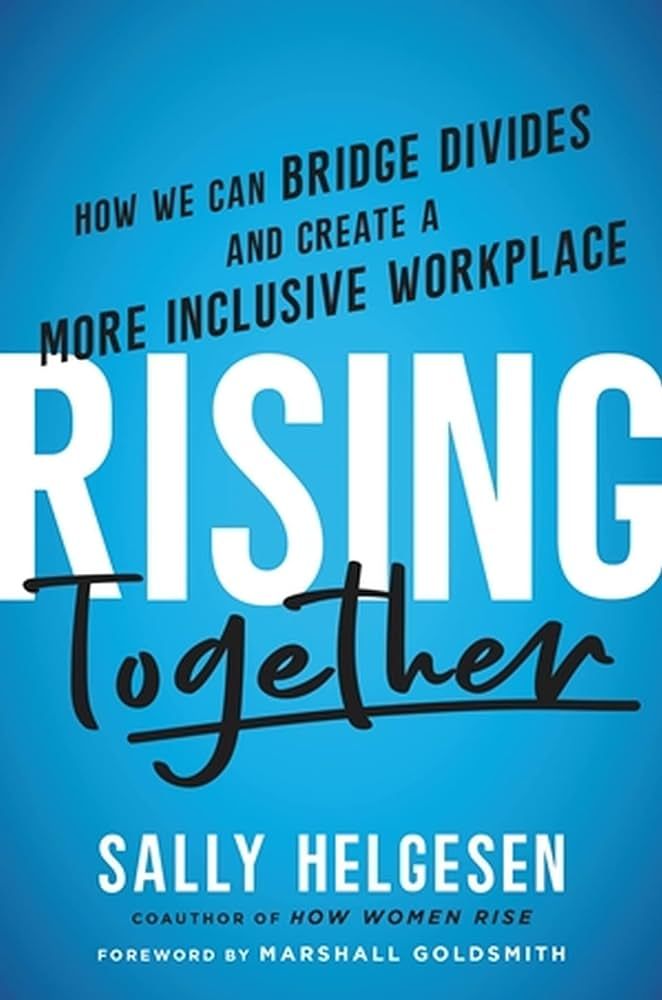We Rise By Creating More Inclusive Workplaces
An ALJ Book Review of Rising Together by Sally Helgesen
Behaviors and actions play a crucial role in shaping feelings, beliefs, and perceptions within an organization. Those behaviors and actions include efforts around inclusion – something that should be much more than just a buzzword around the office. Instead, it should be a measurable and achievable practice that organizations strive for.
Embracing diversity has the power to transform even the most complex situations, and making even small behavioral adjustments can lead to deeper workplace relationships. In Sally Helgesen’s latest book, Rising Together: How We Can Bridge Divides and Create a More Inclusive Workplace, Helgesen explores how to create a diverse and inclusive workplace where individuals can nurture workplace relationships, broaden influence, and experience personal growth.
That said, you might be asking yourself:
How can we instill these new feelings, beliefs, and perceptions in ourselves?
In
Rising Together, Helgesen discusses a list of eight triggers that we commonly encounter while identifying ways our responses to these triggers can be managed. Readers will surely experience an “A HA!” moment here (likely several of them).
What Helgesen offers is practical guidance that can help anyone assert their right to be recognized – but in a balanced and healthy way that avoids the kind of self-congratulatory justifications that tend to materialize when we’re feeling defensive.
In Part 1 of Rising Together, Helgesen explores the eight triggers, and in Part 2, she imparts inclusive practices – the actions we can take to release us from what keeps us from building cultures of belonging. With her examination of this duo – awareness and behaviors – Helgesen speaks to many of the concepts embraced by Agile Leadership Journey through our workshops, programs, and resources.
As you read through each trigger, consider how you would respond to them yourself as well as how you might advise someone you are coaching or mentoring.
Part 1: Eight Common Triggers
Helgesen says that we rise together by understanding the common triggers that can hold us back. Investing too much in our initial responses to triggers can make us more susceptible to being triggered further, making it critical to identify different ways to respond effectively.
Trigger 1: Visibility
We rise together by claiming visibility while acknowledging the contributions of others. Feeling triggered by our own lack of visibility or colleagues who are adept at getting noticed are common, but implementing practices such as interpersonal aikido and sharing the spotlight can help us be noticed in a healthy and balanced way.
Trigger 2: Managing Perceptions
We rise together by neither overmanaging nor undermanaging what others think. This presents a trap for women and people of color, offering no intuitive way out. They often fear being perceived as ambitious, aggressive, or self-centered and are often criticized for behaviors that are routinely accepted from men. Letting go of others' perceptions requires discipline and detachment, and focusing on goals and achievements is essential in overcoming these triggers.
Trigger 3: Confidence and Competence
We rise together by distinguishing overconfidence from competence. Displaying humility and admitting limitations can be challenging – especially in leadership roles. True confidence is rooted in demonstrable skills developed through daily effort, and competence is often underrated, particularly at the leadership level.
Trigger 4: What are You Trying to Say?
We rise together by learning from one another’s communication styles. Balancing authenticity with respectful and persuasive communication, as well as recognizing and addressing differences in communication styles, can help mitigate misunderstandings.
Trigger 5: It’s Not Fair
We rise together by recognizing the extent to which “it’s not fair” is a losing game. Challenging everyday unfairness challenges the larger system. Examining power dynamics, promoting diversity in leadership, and debunking misconceptions about meritocracy are all crucial steps in creating a fair and just organization.
Trigger 6: The Grapevine and the Network
We rise together by knowing how to develop, extend, and leverage our networks. It is important to recognize the characteristics of healthy networks, discuss the current impacts of elitist groups or the role of old boys networks (OBNs), and the importance of external networks that build you up in your career.
Trigger 7: That’s Not Funny
We rise together by getting humor right! There is a place for jokes in the workplace; it can break tension, strengthen bonds, and make work more enjoyable. But often there are unconsidered sensitivities that end up doing more harm than good. Practicing self-awareness and situational awareness around humor can bring people together.
Trigger 8: Attraction, the Uncomfortable Bits
We rise together by acknowledging the role attraction can play in workplace relationships. The Me Too movement created some shifts in interpersonal workplace dynamics and HR policies, highlighting the need for transparency in workplace relationships and the importance of balancing warmth and spontaneity with professional considerations.
Part 2: Creating a Culture of Belonging
The Power of Inclusive Behaviors
We rise together by practicing inclusive habits daily. Our inclusive behaviors have a significant impact on shaping organizational culture and the distinction between diversity and inclusion. There are specific practices for creating cultures of belonging, such as active listening, engaging across levels and divisions, and investing in colleagues' career development.
Informal Enlistment
We rise together by enlisting one another’s support. A culture of belonging includes the importance of enlisting support and accountability for personal and professional development. There are significant benefits to seeking support, demonstrating open-mindedness, and embracing change, even if support is not always available.
Cultivating the Power of We
We rise together by understanding the true nature of power. The power dynamics within organizations play a significant role on whether we can display inclusive behaviors and pursue relationship-building. How you observe and apply the four forms of power – position, expertise, connections, and personal authority – affects the level of satisfaction derived from positively influencing events in the workplace.
Conclusion
Fostering inclusion and overcoming triggers in the workplace is an ongoing journey that requires commitment and consistent effort from both individuals and organizations. By understanding and addressing these triggers, promoting diversity, and embracing inclusion, organizations can create a more equitable and supportive work environment for all.

About Christina Carlson
Christina Carlson guides entrepreneurship through collaboration, creativity, and inspired agility.
Christina is a licensed Agile Leadership Journey Guide, certified Lean Six Sigma Blackbelt, and experienced project leader bringing more than 15 years of proven facilitative success and experience across healthcare, oil and gas, mining, and pharmaceutical industries, as well as small businesses.
Christina finds success and purpose through creativity and collective celebration in her belief that everyone can achieve their dreams.
Connect with Christina on LinkedIn.






